Iberian ham is one of the greatest emblems of Spanish and Mediterranean gastronomy.
However, not all hams are the same, and not even many Spaniards truly know what makes one genuinely special compared to another.
It’s a complex sector, often opaque, that shares only part of the information and, in many cases, is more talked about than truly known first-hand. The variety of factors that influence quality —breed, feeding, curing, labeling— doesn’t make it any easier.
That’s why, in this guide about Iberian ham, I want to shed some light: to help you understand its keys, recognize a good ham and, why not, enjoy it like a true connoisseur.
Table of Contents
History
The production of cured ham is deeply rooted in the history of the Iberian Peninsula. Even in prehistoric cave paintings and stone carvings, there are representations of pig domestication, reflecting its importance for early communities.
With the arrival of the Roman Empire, pork became a staple food in their diet, laying the foundations of what we know today as the first true Mediterranean diet. This pork tradition did not disappear even during the more than 700 years of Muslim presence and the important Jewish community in the peninsula. In the Middle Ages, the consumption and production of pork products remained very much alive.
In the 16th century, an emerging meat-curing industry boosted the development of many villages, some of which gained the status of towns or cities thanks to the fame of their cured products.
From the 19th century onwards, the ham industry experienced a great boom. And it was in the 1960s that a native breed, the Iberian breed, began to stand out as the country’s gastronomic treasure. Its traditional breeding system, combined with the exceptional quality of the final product, made it a unique claim worldwide.
Today, Iberian ham is not just a gastronomic jewel: it’s a cultural icon of Spain, an indisputable reference of the Mediterranean Diet, and a gateway into the way of life and customs of this country.
The Iberian Breed: The Soul of the Ham
Iberian ham would not be what it is without its main character: the Iberian pig. This breed is the result of centuries of evolution and adaptation to the Mediterranean ecosystem, especially to a unique environment like the dehesa. Various studies claim its origin comes from the crossing between native wild pigs (Sus scrofa ferus) and the specific conditions of the southwestern Iberian Peninsula.
Even before the Romans arrived, there were already references to hams coming from “the dehesas of Iberia”, proving the long-standing tradition of this animal in our food culture.
The Iberian pig has evolved as a hardy breed, capable of surviving tough conditions: extreme heat, scarce water or long distances to forage. It is the only one that fully adapts to life in the dehesa, making the most of natural resources like acorns.

Breed Classification of the Iberian Pig
Not all “Iberian” hams come from 100% Iberian pigs. By law, there are three levels of genetic purity:
- 100% Iberian: Both parents are certified Iberian breed, registered in the genealogical book. These are the most highly valued.
- 75% Iberian: The mother is 100% Iberian, the father is 50% Iberian (cross of an Iberian mother and a Duroc father).
- 50% Iberian: The mother is 100% Iberian and the father is Duroc. Even though it has only half Iberian genetics, it can be marketed as Iberian ham (with the proper label).
In addition, there are different varieties within the pure Iberian breed, many of which are today in danger of disappearing. Some of the most recognized are:
- Iberian entrepelado
- Iberian lampiño
- Iberian manchado de Jabugo
- Iberian retinto
- Iberian torbiscal
The Pig’s Life: Montanera, Arrobas and Certification
One of the key moments in an Iberian pig’s life is the montanera — the period when it feeds on acorns in the dehesa. For a pig to qualify for this system and earn the prized “de bellota” label, it must meet certain requirements:
- Minimum age: 14 months.
- Minimum weight before montanera: measured in arrobas (a traditional rural unit equal to 11.5 kg).
- Expected weight at slaughter: also measured in arrobas, allowing calculation of how much weight it gained exclusively from acorns. Example: if it enters with 9 arrobas and leaves with 14, it gained 5 purely from acorns.
The entire process is regulated and supervised. A certifying body controls the initial weight and can visit at any time during montanera to verify the animal is still free-range and feeding on acorns. If there aren’t enough acorns on the ground or in the trees, the pig loses its category and is downgraded to “cebo de campo”, resulting in a significant economic loss for the farmer.
This is why authentic acorn-fed hams cost over €500, and why you should be wary of one labeled as such for €130 outside the official standard.
👉 Curious about the deeper meaning of living Mediterranean-style? Read “Whispers of Thought: Mediterranean Lifestyle Beyond Material” .
What Does an Iberian Pig Eat? Acorns, Feed, and Everything You Need to Know
Alongside the breed, feeding is the other major factor that determines the quality of Iberian ham. It influences not just the flavor, texture, or price but also the pig’s lifestyle: whether it lives freely or on a farm, fed with acorns or with compound feed.
The official Iberian ham quality standard classifies pigs according to their diet and farming system. We can distinguish three main categories:
1. 100% Iberian Acorn-Fed Ham (or crossbred)
Acorn-fed pigs are the kings of Iberian ham. Their final fattening stage happens freely in the dehesa, feeding exclusively on acorns, roots, grasses, and other natural resources. This system is the most demanding but also the one that produces the most exceptional hams.
What must a farm meet to produce “acorn-fed” ham?
Not just any land will do:
- It must have a sufficient number of holm oaks or cork oaks.
- The number of trees and the quality of their fruit determine how many pigs can be fattened solely on acorns.
- If there are few trees or a bad acorn year (quite common if spring has little rain), the number of pigs must be reduced, or they lose the category.

Balancing trees and pigs is almost a rural art.
If too many pigs are kept and there are not enough acorns, quality drops. But if too few pigs are kept, the fruit is wasted — it’s neither collected nor sold.
Fun fact: Acorns are neither stored nor harvested — the pigs eat them straight from the ground. If they don’t eat them, they rot.
When does the montanera take place?
The montanera is the golden season in the countryside:
- Entry: between October 1 and December 15.
- Slaughter: between December 15 and March 31.
A pig with a good montanera can go from ordinary to producing an outstanding ham. That’s why, for farmers, it’s the most beautiful and crucial time of the year.
Technical requirements:
- Initial weight when entering montanera: 92–115 kg.
- Minimum gain exclusively from acorns: +46 kg over more than 60 days.
- Minimum age at slaughter: 14 months.
- Minimum carcass weight: 115 kg (except 108 kg if it’s 100% Iberian).
2. Iberian Cebo de Campo Ham
These pigs live in extensive or semi-open farms. They are fed with compound feed made mainly of cereals and legumes but also graze in the fields and eat wild grasses. They have more freedom than farm pigs but don’t reach the excellence of acorn-fed ones.
Key requirements:
- Life outdoors or semi-open, with at least 100 m² per animal (if weighing over 110 kg).
- Minimum age at slaughter: 12 months.
- Minimum carcass weight: 115 kg (108 kg if 100% Iberian).
- Minimum stay on the farm before slaughter: 60 days.
3. Iberian Cebo Ham
Cebo pigs are raised and fattened exclusively in intensive farms, with no access to the countryside or the dehesa. They are fed only with compound feed and represent the most basic (and cheapest) level of Iberian ham.
Minimum requirements:
- Life in a farm with at least 2 m² of free space per animal.
- Minimum age at slaughter: 10 months.
- Minimum carcass weight: 115 kg (108 kg if 100% Iberian).
Why Can an Acorn-Fed Ham Cost Three Times More Than a Cebo Ham?
The difference isn’t just about flavor — it’s about cost, time, risk, and effort:
- The montanera requires more land, more time, and more oversight.
- Inspections to certify that pigs are eating acorns are strict.
- If there aren’t enough acorns, the ham loses its category and its value: from €500 it can drop to €200.
- Even so, some sell hams labeled “acorn-fed” for €130: they probably aren’t genuine.
Handling the Iberian Pig: The Difference You Can’t See, But You Can Taste
When we talk about Iberian ham, one of the key factors —often overlooked by the consumer— is the handling of the animal. That is, the set of practices related to its breeding, feeding, reproduction, and care. And yes: it makes the difference. A big difference.
Decades ago, this didn’t matter much because ham was a more rural product, without the big industry and brands that dominate today. But nowadays, where every detail counts and prices can skyrocket, understanding handling is essential.
There are two main Iberian pig handling systems: extensive and intensive. Both directly influence the final ham quality.
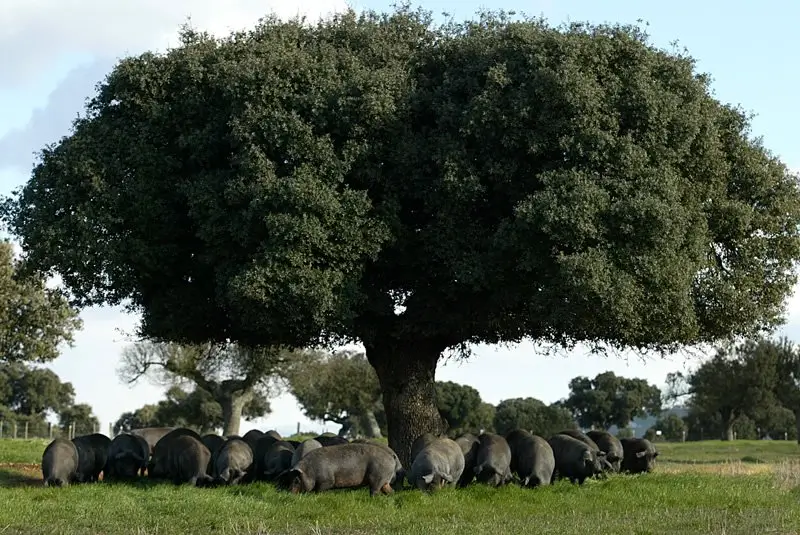
1. Extensive breeding
This is the traditional system. The pig lives freely in the dehesa, a natural ecosystem with holm oaks, cork oaks, and pastures. Here, it can move, forage for food (acorns, roots, grasses) and grow more slowly and evenly.
The result: tastier meat, better texture, and marbling.
2. Intensive breeding
In this model, pigs are raised in closed facilities or barns (known as cebaderos), where they receive a controlled diet based on cereals and legumes. They have less space, less movement, and a faster growth rate.
The result: a decent ham, but no comparison to the previous one.
How Big Is the Difference, Really?
The difference is massive — no exaggeration. A pig that grows freely in the dehesa develops meat with superior quality, deep flavor, and unmistakable aroma. This isn’t clever marketing; it’s the result of genetics, exercise, fresh air, time, and a natural diet.
A free-range ham costs more, but it’s worth every cent. Once you taste it, you know exactly why.
From Field to Table: How Is a Ham Made?
Now that you know how the Iberian pig is raised and fed, it’s time to understand the ham-making process.
From slaughter to the moment that ham reaches your table, there are several key stages that directly impact its quality.
There are four main stages: montanera, salting, curing, and refinement. Let’s break them down one by one.
Montanera: What Makes Acorn-Fed Ham Unique
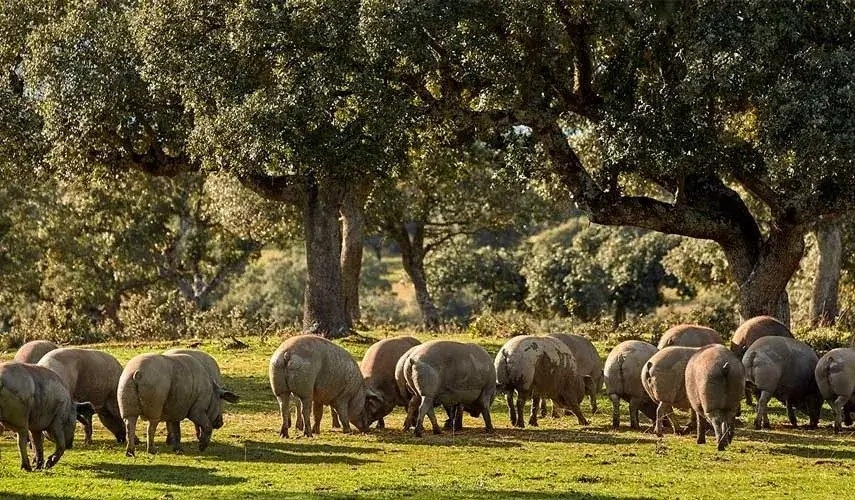
If you should remember one thing, let it be this: without montanera, there is no acorn-fed ham. It’s the final “push” that brings the pig to its highest level.
The montanera is the period when Iberian pigs live freely in the dehesa and feed exclusively on acorns and natural pastures. It starts in October and ends between February and March, when it’s time for slaughter.
During these months, it’s strictly forbidden to provide any kind of feed or supplement. If this rule is broken, the herd is immediately disqualified from the “acorn-fed” category. They can be sold as cebo de campo, but never as acorn-fed Iberian.
The dehesa is a unique ecosystem, made up of holm oaks, cork oaks, and gall oaks. These trees produce the acorns that the pigs enjoy during their long walks — up to 14 kilometers a day.
In those long walks, the animals grow while searching for the best acorns, exercising their muscles and distributing fat evenly throughout their tissue.
This fat is rich in oleic acid, the same monounsaturated fat found in olive oil, which helps reduce cholesterol and prevent cardiovascular disease. Oleic acid comes directly from the acorns, which are the pig’s main food during montanera.
Acorns also provide other essential nutrients, such as vitamins, minerals, and natural antioxidants that make their legs a healthy product.
Requirements to enter montanera:
- Minimum age: 14 months
- Initial weight: between 92 and 115 kg (8 to 10 arrobas)
- Final weight before slaughter: at least 160 to 180 kg (14 arrobas)
- At least one hectare of dehesa for every two pigs, with good acorn density
These weights and minimum ages are mandatory to ensure each pig spends enough time eating only acorns.
If the pig doesn’t reach 14 arrobas during montanera, it will be disqualified and will not be labeled as acorn-fed Iberian.
Montanera is a traditional and sustainable process that respects the ecological balance of the dehesa and helps conserve it.
Iberian pigs act as natural cleaners and soil fertilizers, eating fallen acorns and leaving their droppings. This prevents the spread of pests and diseases and supports vegetation regeneration.
Montanera also brings social and economic benefits to rural areas, creating jobs and income.
In short, montanera is an essential stage for the Iberian pig and gives it the best possible feed.
Salting: The First Transformation
After slaughter, the first step in the curing process is salting — an ancient method introduced by the Phoenicians to preserve meat.
This process has three steps:
- Preparation and cleaning: The legs are cleaned and trimmed, removing any unwanted tissue. This is when the characteristic ‘V’ cut is made on Iberian hams.
- Salting: The ham is buried in sea salt. The amount of salt and duration vary according to the ham’s size and quality. The usual rule is one day per kilo of weight. So, an 8 kg ham stays buried in salt for about 8 days.
- Washing: After resting in salt, each leg is washed to remove excess surface salt. Then it’s hung in the drying shed, where the settling begins.
There is an intermediate step, now less common, called “turning”: halfway through the salting period, the hams are lifted, and the ones on top of the pile are moved to the bottom.
This is expensive and time-consuming — it takes a full day — so many producers skip it. Personally, I like it; it’s something the old folks always did, and I don’t want the tradition to be lost. It also helps the salt distribute more evenly.
This stage is the most critical in a ham’s life: a bad salting ruins the entire process and a customer’s experience down the line.
Every experienced ham master understands this and uses their knowledge to achieve the perfect balance of flavor, texture, and preservation in each piece.
Curing: Where the Magic Happens
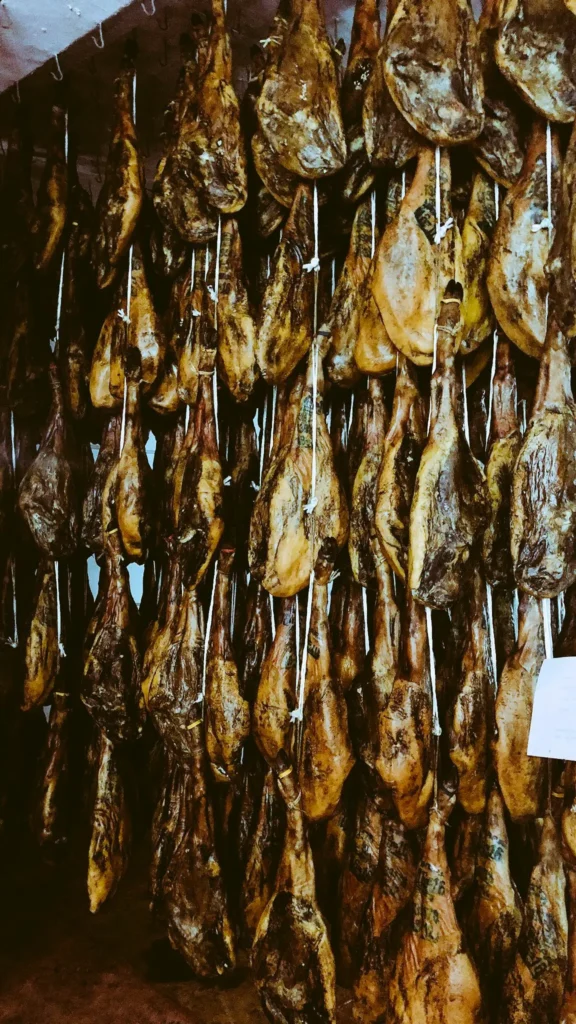
Curing is where the real magic happens. It’s about giving each piece the time it needs to develop its best flavor and aroma — no shortcuts, just patience and skill.
This is the most rewarding stage. Anyone can raise a pig and salt a ham, but curing it properly, year after year, is an art mastered by only a few.
This phase happens in the secadero, a stone building with thick walls, a cool underground cellar (bodega), a stable ground floor, and an upper floor that catches the right amount of mountain air.
In my village, Cumbres Mayores — within the Jabugo D.O. — we still use the old method: windows. Opening and closing them controls temperature and humidity naturally. The clean mountain air flows through, and that’s what gives each ham its unmistakable artisanal aroma.
Here’s how it works
- First year: Each piece stays on the ground floor, where the temperature is stable. The freshly salted legs still have a lot of moisture inside, and sudden temperature changes could spoil them.
- Gradually: As spring and summer arrive, the temperature rises slowly until the cold returns.
- In autumn: With the first cold snaps, the hams are moved to the top floor. By then, they are settled and won’t spoil if the temperature outside rises again in spring — they just need to “sweat” during summer.
This arrangement is no accident: each floor is oriented to ensure the ideal temperature at each time of year. The ham master fine-tunes the indoor conditions by opening or closing windows according to the weather.
Curing is where the real magic happens. It’s about giving each piece the time it needs to develop its best flavor and aroma — no shortcuts, just patience and skill.
This is the most rewarding stage. Anyone can raise a pig and salt a ham, but curing it properly, year after year, is an art mastered by only a few.
This phase happens in the secadero, a stone building with thick walls, a cool underground cellar (bodega), a stable ground floor, and an upper floor that catches the right amount of mountain air.
In my village, Cumbres Mayores — within the Jabugo D.O. — we still use the old method: windows. Opening and closing them controls temperature and humidity naturally. The clean mountain air flows through, and that’s what gives each ham its unmistakable artisanal aroma.
Here’s how it works
- First year: Each piece stays on the ground floor, where the temperature is stable. The freshly salted legs still have a lot of moisture inside, and sudden temperature changes could spoil them.
- Gradually: As spring and summer arrive, the temperature rises slowly until the cold returns.
- In autumn: With the first cold snaps, the hams are moved to the top floor. By then, they are settled and won’t spoil if the temperature outside rises again in spring — they just need to “sweat” during summer.
This arrangement is no accident: each floor is oriented to ensure the ideal temperature at each time of year. The ham master fine-tunes the indoor conditions by opening or closing windows according to the weather.
Refinement: The Final Selection
The fourth and final stage is the one that makes sure you and I enjoy a truly outstanding ham. This is when the best is separated from the rest.
Each piece is chosen by texture and aroma — only the crème de la crème makes the cut. In the cellar, special lots and reserves are organized based on the type of customer and the perfect point of curing. If you’ve ever bought from this brand — the one with the pig in a cape — you’ll know each piece is numbered (like #001/100). Those top 100 are handpicked at this stage.
Unfortunately, the pressure for faster sales and bigger volumes means some big brands skip this step — and that hurts the whole Iberian sector. Giving each ham the time it needs to reach its peak isn’t optional; it’s essential.
This refinement stage is crucial because no two pigs are identical, and no two hams turn out the same. In a process that takes years, each ham or shoulder needs its own timing and care, depending on its size and quality.
The best cuts — the acorn-fed ones — always need a longer, slower natural cellar aging than a standard recebo.
These are the stages a ham goes through before it’s ready for slicing.
Iberian Ham Prices and Which One to Choose (Without Being Fooled)
Now that you know where it comes from, how it’s raised, and how it’s made… here’s what everyone really wants to know:
Which ham should I buy? Which is good? Why does one cost €120 and another €500?
Here are the main types of Iberian ham explained in plain language, with real-life examples.
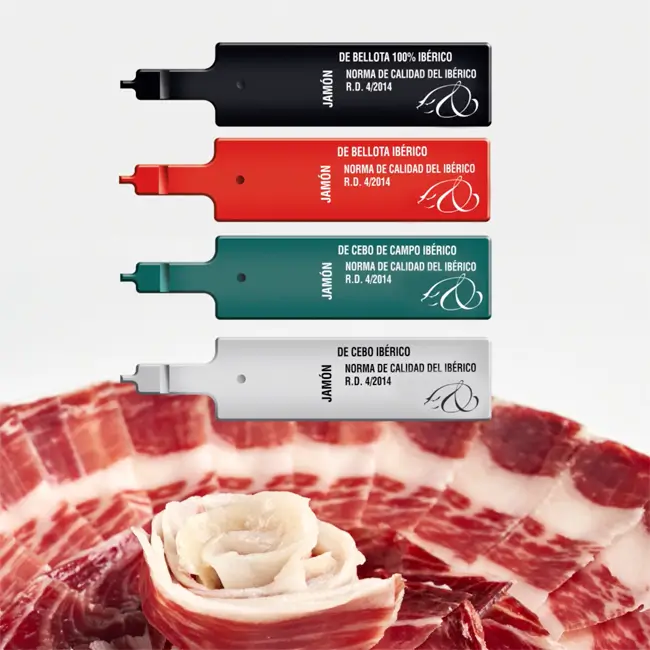
100% Iberian Acorn-Fed Ham (Black Label)
The top of the top.
For those who want the best and don’t mind paying €450 or more.
- Purebred, free-range, fattened only on acorns.
- Long curing periods (up to 48 months).
- Intense flavor, long-lasting aftertaste, and fat that melts in your mouth.
- You need decent knife skills to cut it properly, or buy it pre-sliced.
Not for you if… you prefer mild flavors or don’t like a lot of fat.
Perfect for you if… you want an impressive piece that will wow everyone at a wedding or special dinner.
Tip: If you want to try it without spending too much, a shoulder (which has less yield but more flavor) costs around €180–220.
75% or 50% Iberian Acorn-Fed Ham (Red Label)
Same acorn flavor, more affordable.
Starting at €250–350 for a whole ham. Better yield than 100% Iberian and less external fat.
- Crossbred, but same feeding: acorns and dehesa.
- Slightly shorter curing, but very balanced flavor, even slightly sweet.
- Great value for money. Easier to slice.
Not for you if… you believe only 100% Iberian is worth it.
Perfect for you if… you want delicious ham with acorn aroma, good marbling, and no hassle.
Very popular for family gatherings or when you have guests. There are also XL shoulders of 5–6 kg for around €120–180.
Iberian Cebo de Campo Ham (Green label)
A practical option without giving up flavor.
- Iberian breed (50–100%), raised outdoors but fattened with feed and wild grasses.
- Good texture, milder taste.
- Ideal for regular consumption and budgets of €150–250.
Not for you if… you’re after that deep acorn taste.
Perfect for you if… you want decent Iberian ham for the house without spending a fortune.
Tip: Make sure it says de campo (field), not just cebo.
Iberian Cebo Ham (White label)
The most basic of the Iberian range. The kind you find in big supermarkets.
- Farm-raised, fattened on feed.
- Decent, nothing more. Price range €90–150.
I don’t produce this, and I never will. If you need a budget ham, it’s better to get a family-farmed one — handmade, naturally cured, and with real flavor.
Private Collection Ham
The signature ham. Out of the standard. Made the traditional way.
- No official label, but made with lots of care.
- Raised and cured like the old days: no rush, no big volume, no colored seals.
- More affordable, spectacular flavor.
Not for you if… you need an official label to trust it.
Perfect for you if… you believe in the craftsman more than the certification. And yes, if you don’t like it, I’ll refund you.
Out-of-Standard Ham
A world apart.
- Doesn’t follow the official Iberian standard.
- It can be an excellent ham… or a scam disguised as a deal.
- Can’t be legally labeled “Iberian”.
Heads up: If you see an “acorn-fed ham out of standard” for €130, it’s not acorn-fed. It’s impossible.
✅ Some honest producers choose to stay out of the standard to have freedom: to make smaller hams, cure them at their own pace, and skip certification costs.

In Summary
There’s no single ham that’s perfect for everyone — but there is one that’s perfect for you. It all comes down to what you like, what you’re willing to pay, and how much effort you want to put into slicing and serving it right.
A good ham is an investment in flavor and in time well spent with family or friends. So take your time, compare, and don’t get carried away by big promises or suspicious bargains.
And if you’re ever in doubt, ask before you buy. It’s always better to get advice than to spend €500 on a piece that doesn’t fit what you really want. Better to ask once than regret it later.
In the end, the best ham is the one you enjoy — without stress, without surprises, and with the confidence that you chose it well. And when you finally slice it, take your time. Savor it. Good ham is made to be enjoyed, not rushed.
What’s the difference between Serrano ham and Iberian ham?
Serrano ham comes from white pig breeds (like Duroc or Landrace) and is usually milder and more uniform. Iberian ham comes from the unique Iberian breed and has rich marbling that gives it a deeper, more complex flavor — especially when acorn-fed.
How should I store an Iberian ham at home?
If you have a whole leg, keep it in a cool, dry place, ideally hanging or on a jamonero stand. Once you start slicing, cover the exposed area with its own fat or plastic wrap to keep it from drying out. For pre-sliced ham, store it in the fridge and open it 15 minutes before eating.
How long does an Iberian ham last once opened?
A whole leg can last about 1–2 months if sliced regularly and properly covered. Vacuum-packed slices should be eaten within a few days once opened.
How do I know if a ham is really acorn-fed?
Check the official label color: black means 100% Iberian acorn-fed; red means 75% or 50% Iberian acorn-fed. If you see ‘acorn-fed’ without a proper label or at an unusually low price, be cautious — real acorn-fed ham is always certified and never cheap.
Recommended Sources
-
Iberico.com – Asociación Interprofesional del Cerdo Ibérico (ASICI)
Official website representing the Iberian pig sector: traceability, quality standards, and sector promotion. -
Ministry of Agriculture – Mesa de Coordinación de la Norma de Calidad del Ibérico
Coordination group overseeing and interpreting the Iberian Quality Standard with ASICI, ENAC, D.O.P. councils and regional authorities. -
Ministry of Agriculture – Interpretation Agreements
Official agreements ensuring consistent application of the Iberian ham regulations. -
Ministry of Agriculture – Action Protocols
Access to updated inspection and certification protocols for Iberian pig traceability and quality.

Spanish Latte Recipe: Mediterranean Coffee Tradition Meets Modern Café Culture
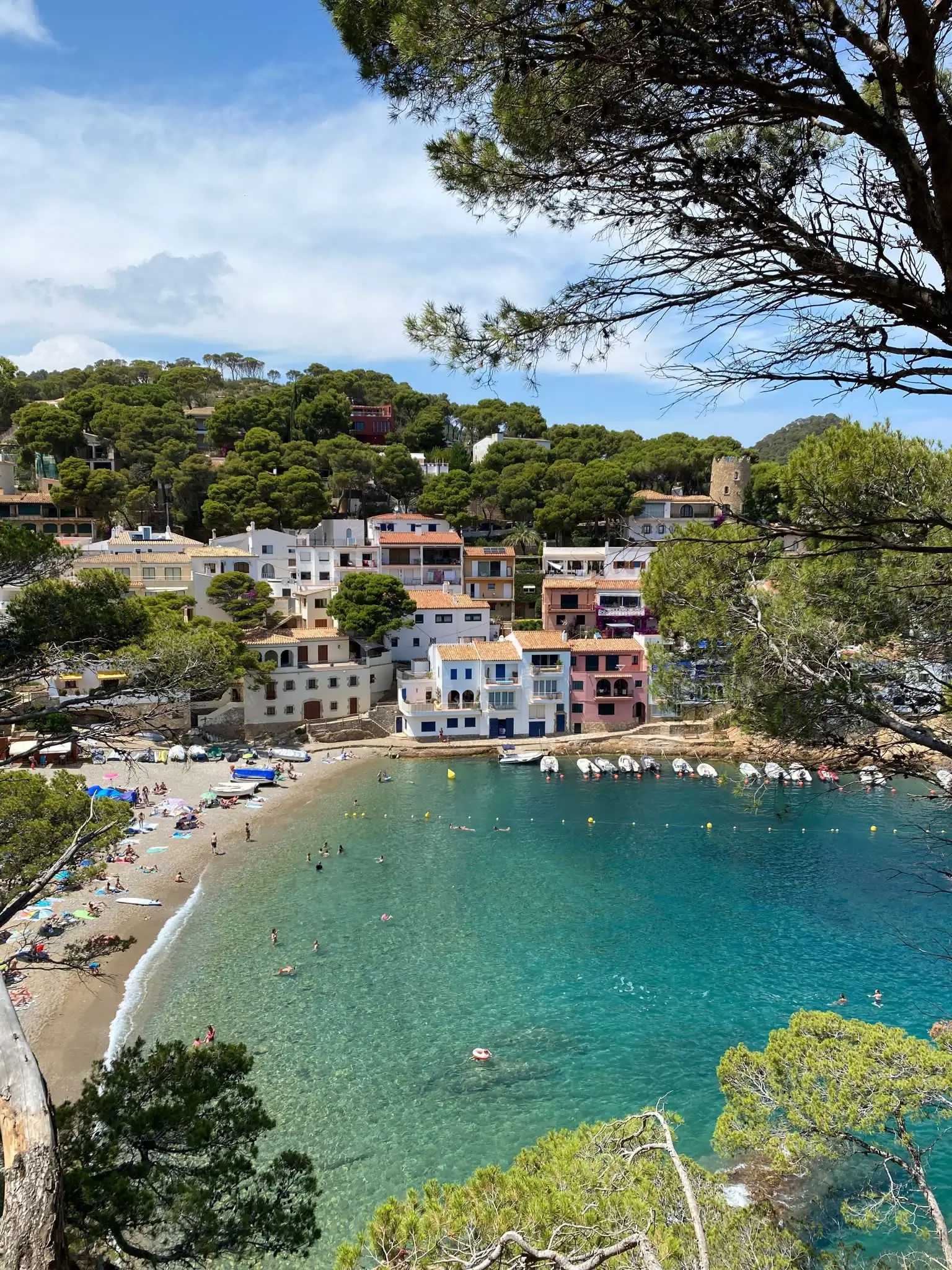
Costa Brava Without the Crowds: Peaceful Towns, Coastal Trails, and Honest Local Tips

What Is a Mediterranean Aperitivo? Meaning, Food and Ritual


